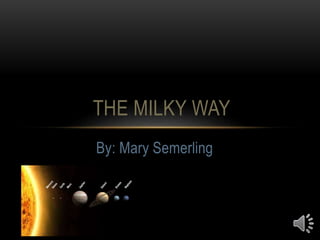Milkyway 2
- 1. THE MILKY WAY By: Mary Semerling
- 2. THE 8 PLANETS Mercury Venus Earth Mars Jupiter Saturn Uranus Neptune
- 3. MERCURY • Mercury is the closet planet to the sun. • Mercury looks like earth’s moon. • Mercury is now our solar systems smallest planet.
- 4. VENUS • Venus is the second planet from the sun. • Venus is similar to earth in size and mass. • Venus is covered with permanent blankets of clouds. • Venus is hot
- 5. EARTH • Earth is the third planet from the sun. • Earth has a atmosphere that sustains life. • Earth has liquid water.
- 6. MARS • Mars is the fourth planet from the sun. • Mars has a thin atmosphere as well as a wide network of canyons and river beds. • Mars is called the red planet. • Mars once had a warm wet earth-liked climate.
- 7. JUPITER • Jupiter is the fifth planet from the sun. • Jupiter is the largest planet. • Jupiter has no solid surfaces.
- 8. SATURN • Saturn is the sixth planet from the sun. • Saturn rings are around all of the gas giants.
- 9. URANUS • Uranus is the seventh planet from the sun. • Uranus is a gas planet.
- 10. NEPETUNE • Neptune is the eighth planet from the sun. • Neptune is a gas giant. • Neptune appears blue through a telescope.









